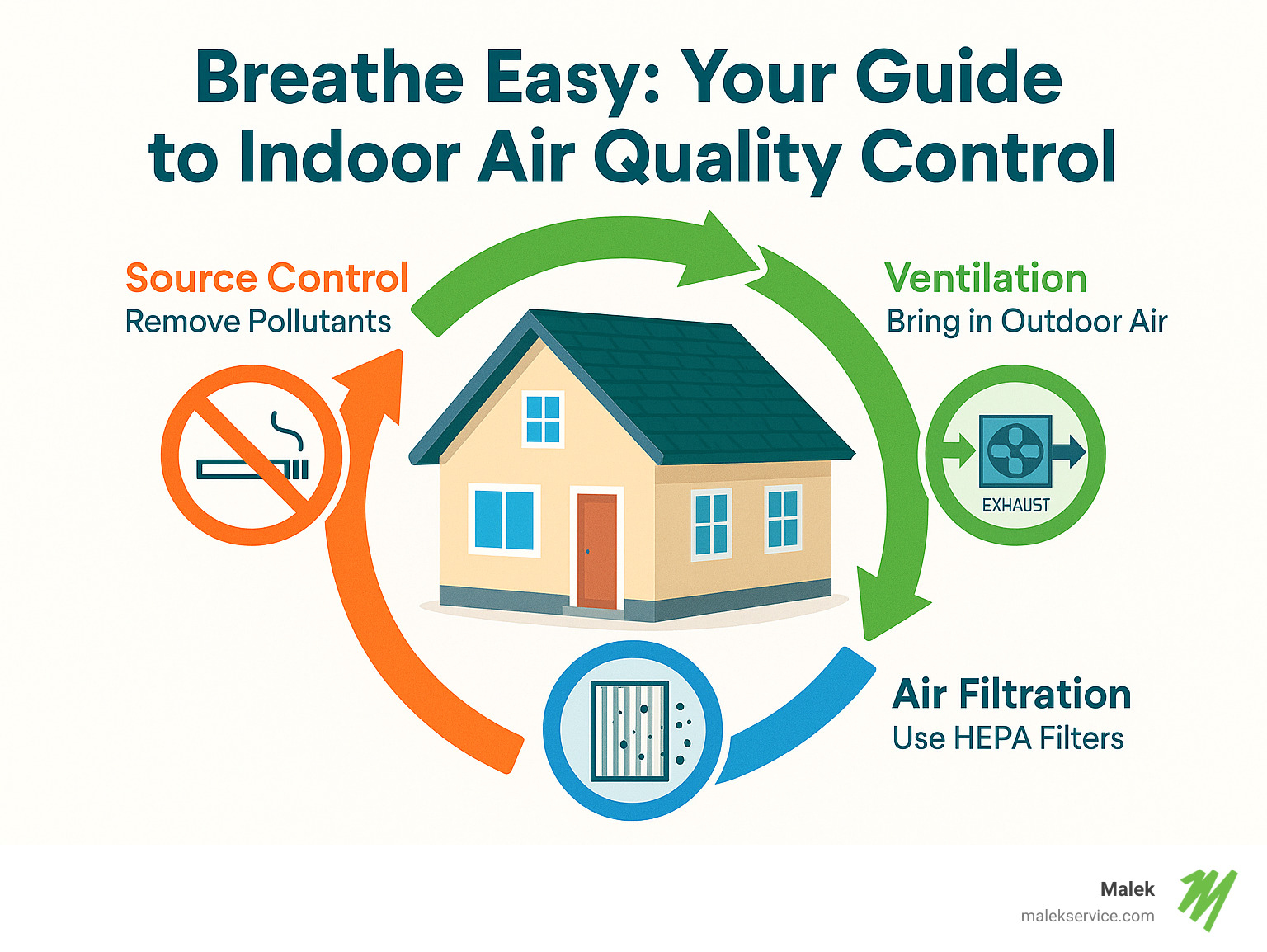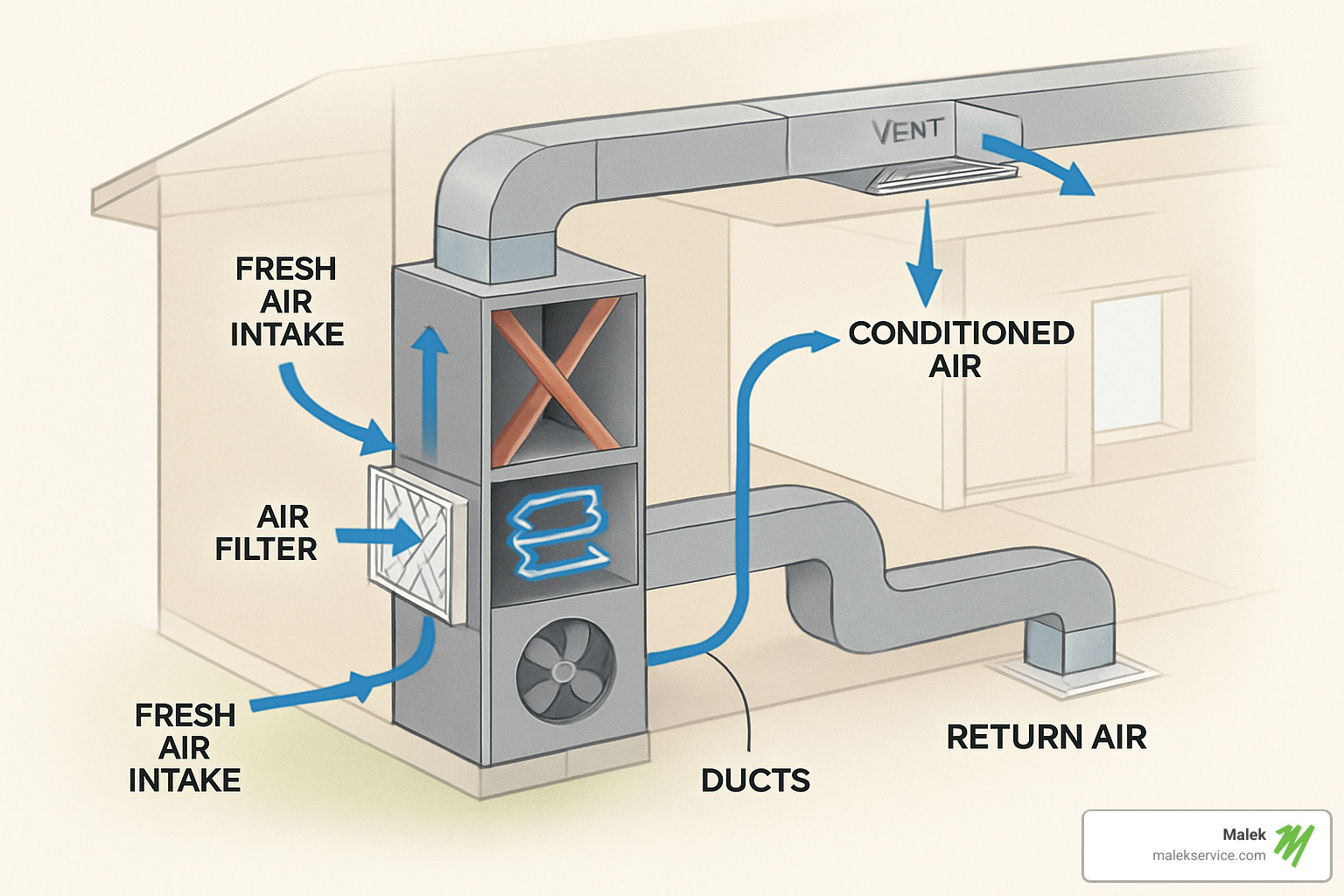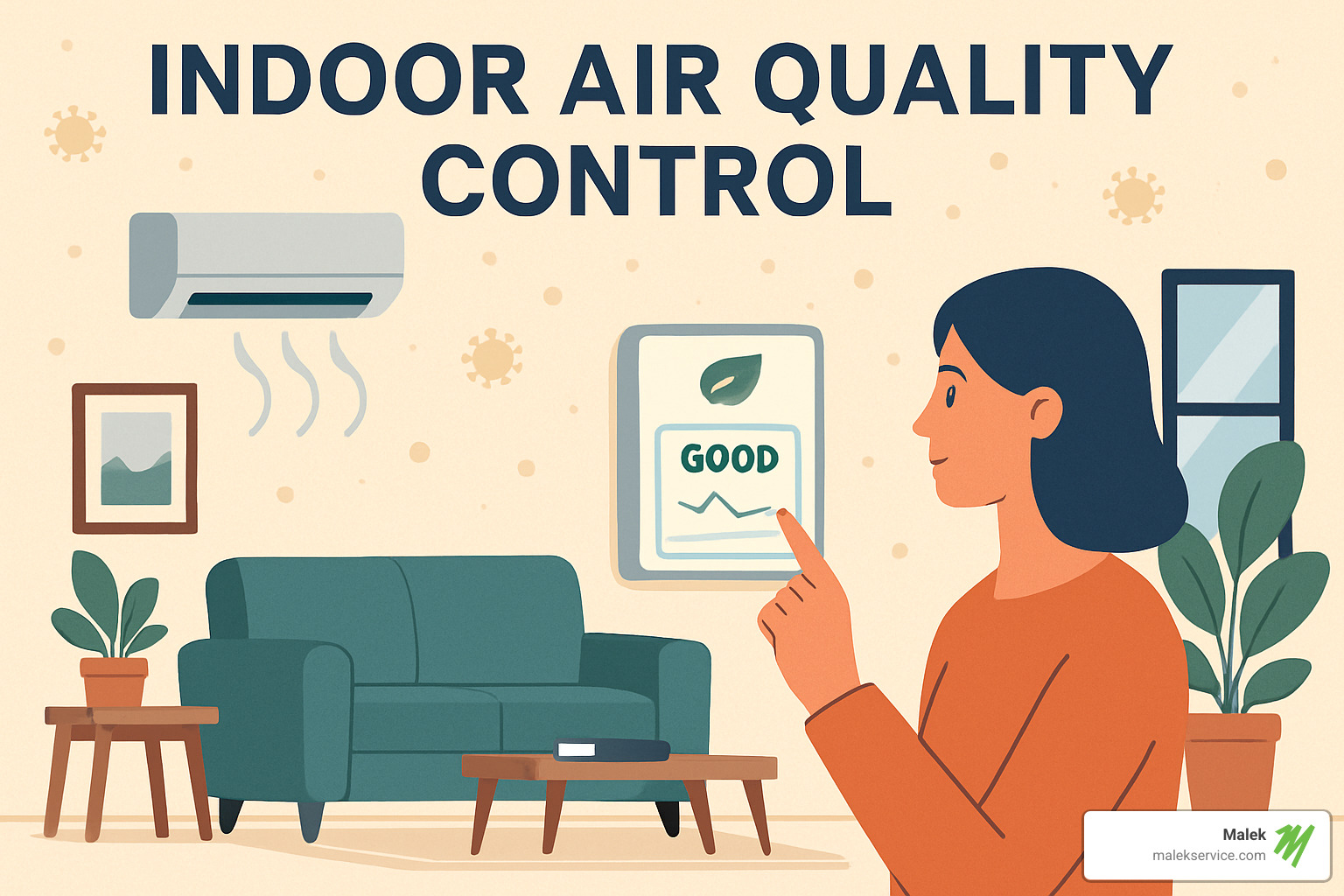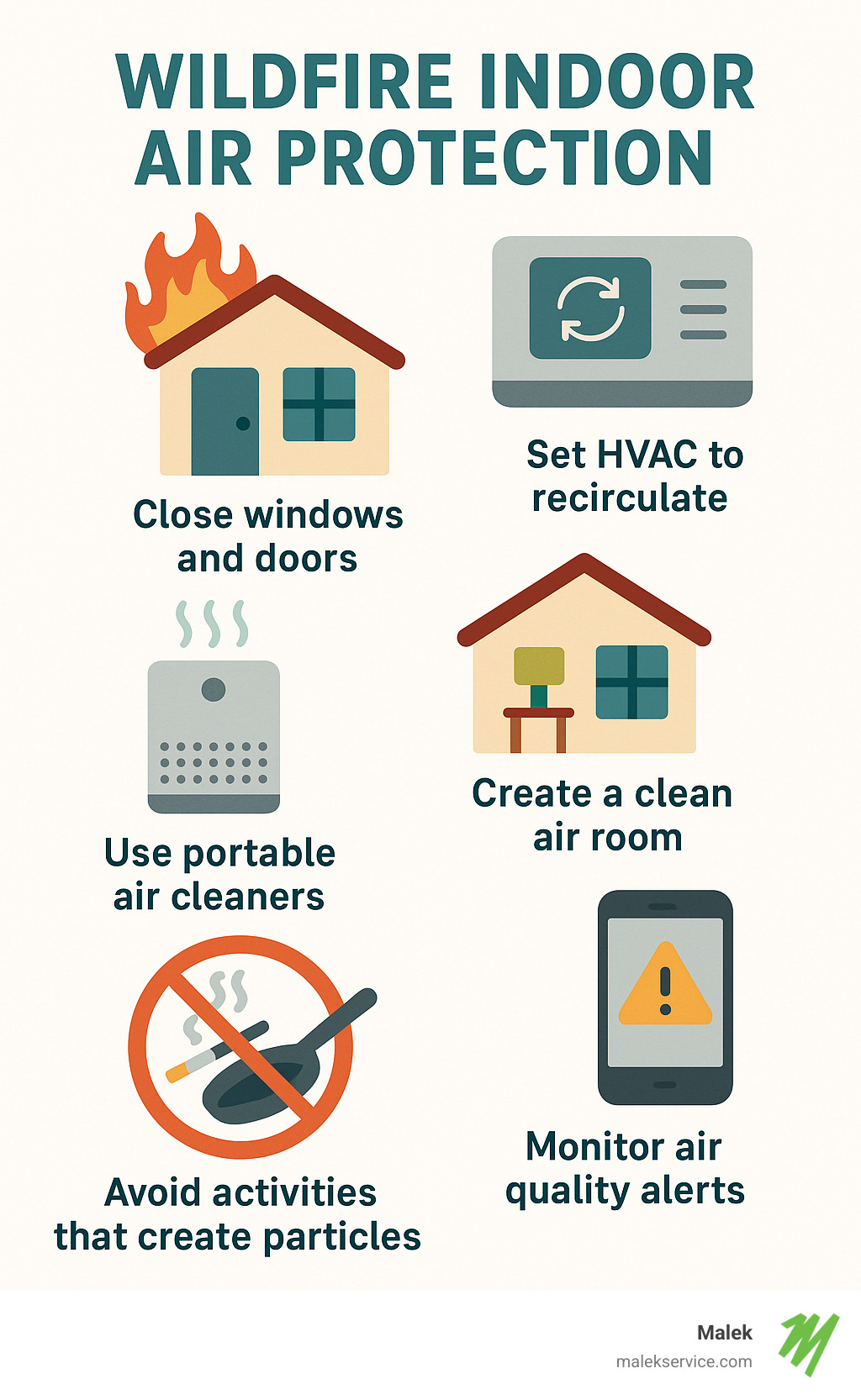Why Indoor Air Quality Control Matters More Than You Think
Indoor air quality control is the practice of managing pollutants, ventilation, and filtration to maintain healthy air inside buildings. With Americans spending about 90% of their time indoors, the air you breathe at home directly impacts your family’s health, comfort, and daily well-being.
The three main strategies for indoor air quality control are:
- Source Control – Remove or reduce pollution sources
- Ventilation – Bring in fresh outdoor air and exhaust stale indoor air
- Air Cleaning – Filter particles and contaminants from indoor air
Poor indoor air quality can cause headaches, respiratory symptoms, and worsen allergies or asthma. The World Health Organization estimates that 3.8 million deaths worldwide each year are linked to indoor air pollution.
Common indoor pollutants include:
- Radon (leading cause of lung cancer in non-smokers)
- Carbon monoxide from fuel-burning appliances
- Mold and biological contaminants
- Volatile organic compounds (VOCs) from furniture and cleaning products
- Fine particles from cooking and outdoor sources
I’m Courtney Zalesak, Vice President at Malek Service Company, where I’ve spent over a decade helping Texas families improve their home comfort through better HVAC systems and indoor air quality control solutions.

What This Guide Covers
This comprehensive guide covers everything you need to know about indoor air quality control for your home and workplace. We’ll walk you through identifying pollutants, implementing the three core control strategies, and maintaining healthy air year-round.
Understanding Indoor Air Quality (IAQ)
Indoor air quality means how clean and healthy the air is inside your home or office. The EPA defines good indoor air quality as having no harmful pollutants at dangerous levels, with at least 80% of people feeling comfortable breathing the air.
The air inside your home can actually be two to five times more polluted than outdoor air, even in major cities. Indoor spaces trap pollutants that build up over time without proper ventilation.
Scientific research on global burden reveals that indoor air pollution contributes to millions of health problems worldwide. The EPA estimates that radon gas alone causes about 21,000 lung cancer deaths every year in the United States.
Some people face higher risks from poor indoor air than others. Children are especially vulnerable because their lungs are still developing. Older adults often have weakened immune systems. If you or someone in your family has asthma, allergies, heart disease, or chemical sensitivities, poor indoor air quality can make these conditions much worse.
“Sick building syndrome” occurs when people consistently feel unwell in a particular building but feel better when they leave. Symptoms like headaches, fatigue, or respiratory irritation that improve once you step outside are warning signs that indoor air quality needs attention.
Why IAQ Matters for Health & Performance
Poor indoor air quality control affects more than just physical health. It impacts cognitive function, productivity, and overall quality of life.
When carbon dioxide levels climb too high indoors, your brain doesn’t work as well. Research shows that cognitive performance drops by 12% when CO₂ reaches 1000 ppm. At 2500 ppm, thinking ability plummets by 51%.
Your body sends clear signals when indoor air quality is poor: persistent coughing, sneezing, throat irritation, headaches, and fatigue that lift when you go outside. For family members with asthma or allergies, poor indoor air becomes a daily struggle affecting sleep, school performance, and overall happiness.
At Malek Service, I’ve seen families transform their daily lives simply by addressing indoor air quality issues. When you can breathe easily in your own home, everything else improves: better sleep, fewer sick days, improved focus, and a more comfortable living environment.
Common Indoor Air Pollutants & Their Health Effects
The air inside your home contains a mix of pollutants that fall into three main categories: biological contaminants, chemical gases, and particulate matter. Understanding these pollutants is your foundation for effective indoor air quality control.
Biological Threats
Mold and mildew grow on almost anything organic when moisture is present for 24 to 48 hours. They release spores and toxic compounds called mycotoxins that can trigger sneezing fits to serious asthma attacks.
Bacteria thrive in HVAC systems, humidifiers, and areas with standing water. The dangerous Legionella bacteria particularly loves cooling towers and poorly maintained water systems.
Allergens include dust mites living in mattresses, pet dander, pollen, and insect debris that trigger allergic reactions in sensitive family members.
Chemical Gases
Formaldehyde is everywhere in modern homes – pressed wood furniture, carpet, and fabrics all release this known carcinogen. Even at low levels, it can irritate eyes, nose, and throat.
Volatile Organic Compounds (VOCs) come from paint, cleaning products, and new furniture. That “new car smell” or “fresh paint smell” are VOCs that can cause headaches, dizziness, and respiratory irritation.
Carbon monoxide is the silent killer. Scientific research on carbon monoxide shows how dangerous this colorless, odorless gas can be. Furnaces, water heaters, gas stoves, and fuel-burning appliances can produce carbon monoxide if not working properly.
Nitrogen dioxide comes from gas stoves, kerosene heaters, and tobacco smoke. It’s particularly hard on lungs and can increase susceptibility to respiratory infections.
Particulate Matter
PM2.5 particles are incredibly small (2.5 micrometers or less) and can penetrate deep into lungs and even enter your bloodstream directly.
Cooking is one of the biggest sources of particulate matter in homes. Frying, grilling, burning candles, and fireplace use all release particles. During big holiday meals, particulate levels can spike to over 300 μg/m³ – well above safe levels.
Wildfire smoke has become increasingly serious in Texas. During wildfire season, outdoor air becomes heavily contaminated with fine particles that infiltrate homes without proper precautions.
Indoor Air Quality Control: Three Core Strategies
Effective indoor air quality control requires three strategies working together: source control, ventilation, and air cleaning. Each strategy catches what the others might miss.

Source Control—First Line of Defense
Source control is your most powerful and usually cheapest approach because you’re stopping problems before they start.
Smoking indoors is the biggest enemy of clean air. Make it an outdoor-only rule. When using products with strong fumes, plan ahead – use them when the house will be empty and ensure good ventilation.
Moisture control keeps humidity between 30% and 50% to prevent mold. In Texas, this often means running air conditioning even when it’s not blazing hot. Fix water leaks immediately – mold can start growing within 24 hours. Use bathroom and kitchen exhaust fans every time.
Fuel-burning appliances need annual checkups to prevent dangerous carbon monoxide situations. Keep household chemicals in original containers with tight lids, stored away from living areas.
Ventilation for Indoor Air Quality Control
Ventilation brings fresh outdoor air into your home while pushing stale, contaminated air out.
Opening windows works when weather cooperates and outdoor air quality is good. In Texas heat, you’re not opening windows from May through September.
Kitchen and bathroom exhaust fans should vent outside, not just blow fumes around. Run range hoods every time you cook. Bathroom fans should run during showers and for 30 minutes afterward.
Energy Recovery Ventilators (ERVs) and Heat Recovery Ventilators (HRVs) bring in fresh outdoor air while recovering energy from outgoing air. Energy Saver: Whole-House Ventilation explains how these systems work.
Air Cleaning & Filtration for Indoor Air Quality Control
Your HVAC system filter is probably doing less than you think. Most homes have cheap fiberglass filters that barely catch anything. Upgrading to MERV 13 filters makes a huge difference, grabbing particles as small as 0.3 micrometers.
Not every HVAC system can handle thicker, more efficient filters. Some older systems will struggle with increased resistance, potentially damaging equipment.
HEPA filtration is the gold standard, capturing 99.97% of particles 0.3 micrometers or larger. Portable air cleaners can fill gaps, especially in bedrooms. Look for AHAM certification or CARB listings.
Stay away from ozone generators – ozone is actually a lung irritant and shouldn’t be used where people are present.
Monitoring & Testing Your Air
You can’t fix what you can’t see. Many dangerous indoor pollutants like carbon monoxide and radon are invisible and odorless, making monitoring and testing essential for indoor air quality control.

Carbon monoxide detectors are absolutely non-negotiable. Install battery-powered or hardwired CO detectors on every level, especially near bedrooms and gas appliances. Test monthly and replace batteries annually.
Radon testing should happen in every home. This radioactive gas causes the second leading cause of lung cancer after smoking. Simple DIY test kits work for initial screening. If levels exceed 4 pCi/L, mitigation is needed.
Modern air quality monitors track multiple parameters in real-time: temperature, humidity, CO₂, fine particles (PM2.5), and volatile organic compounds. They help you understand how daily activities affect air quality.
CO₂ monitoring indicates ventilation problems. When outdoor CO₂ sits around 400-600 ppm, indoor levels should stay reasonably close. Readings consistently above 1000 ppm signal your home needs more fresh air.
Interpreting Guidelines & Exposure Limits
WHO recommendations offer 24-hour average limits – PM2.5 shouldn’t exceed 15 μg/m³. EPA action levels exist for pollutants like radon (4 pCi/L).
These are guidelines, not magic numbers. Some people may experience symptoms at lower levels. Use these numbers as starting points for indoor air quality control decisions, erring on the side of caution for family protection.
Special Situations & Seasonal Challenges
Special situations require extra attention to maintain effective indoor air quality control.

Wildfire smoke has become a regular concern in Texas. When air quality alerts appear, keep windows and doors sealed tight. Use your HVAC system’s recirculate setting to stop pulling in smoky outdoor air. Portable HEPA air cleaners become essential, especially in bedrooms.
Avoid indoor activities that worsen air quality during smoke events: don’t fry foods, light candles, or use fireplaces.
Water damage and flooding create a race against time. Mold doesn’t wait – it can start growing within 24 hours. Remove water immediately. Carpets, drywall, and furniture that stay wet for more than two days usually can’t be saved.
Renovation projects can fill your air with dust, paint fumes, and contaminants from old walls. Schedule messy work when your family can stay elsewhere. Use plastic sheeting to contain work areas and run exhaust fans to pull contaminated air outside.
Have emergency supplies ready: extra air filters, portable air cleaners, and contact information for water damage restoration professionals.
Frequently Asked Questions about Indoor Air Quality Control
What are the warning signs of poor IAQ?
Your family’s health provides the first clues. Pay attention when family members sneeze or cough frequently indoors, wake up with headaches or congestion, or experience eye, nose, and throat irritation that improves outside.
For asthma sufferers, poor indoor air quality control shows up as more frequent episodes or increased rescue inhaler use.
Environmental clues include musty smells, visible mold, persistent dust, and condensation on windows during mild weather.
How often should I replace HVAC filters?
This depends on your specific home situation. Standard 1-inch filters typically need changing every 1-3 months. Higher-efficiency filters like MERV 11-13 can often go 3-6 months.
Homes with pets need more frequent changes – sometimes monthly during shedding seasons. During Texas pollen seasons, check filters monthly. During wildfire events, you might need weekly replacements.
The best approach: check your filter monthly and trust what you see. If it looks dirty or airflow seems reduced, change it regardless of timing.
Do houseplants really purify indoor air?
While houseplants are wonderful for brightening your home, they won’t solve air quality problems. The confusion comes from NASA studies in the 1980s under very controlled laboratory conditions.
To get meaningful air cleaning from plants, you’d need hundreds of plants per room. Even then, the effect would be minimal compared to proper ventilation and filtration.
Stick with proven indoor air quality control methods: eliminate pollution sources, ensure adequate ventilation, and use proper filtration.
Conclusion
Taking control of your home’s air quality is one of the best investments for your family’s health and happiness. When you implement indoor air quality control through source control, proper ventilation, and effective filtration, you create an environment where everyone can breathe easier.
At Malek Service, we’ve been helping Texas families breathe cleaner air for decades. Our licensed HVAC experts understand that indoor air quality control isn’t a cookie-cutter solution. Every home has unique challenges, from older ductwork needing sealing to newer construction requiring better ventilation.
What sets us apart is our commitment to ongoing education and training on the latest air quality technologies. We make sure our technicians stay current on everything from advanced filtration systems to energy recovery ventilators.
Indoor air quality control is a marathon, not a sprint. Regular maintenance keeps your systems working effectively. Start with the basics covered in this guide. Address obvious pollution sources first, then improve ventilation and filtration. You don’t have to tackle everything at once – even small improvements make a meaningful difference.
Your family deserves to breathe the cleanest air possible. With the right approach and professional support when needed, achieving excellent indoor air quality control is absolutely within reach.



